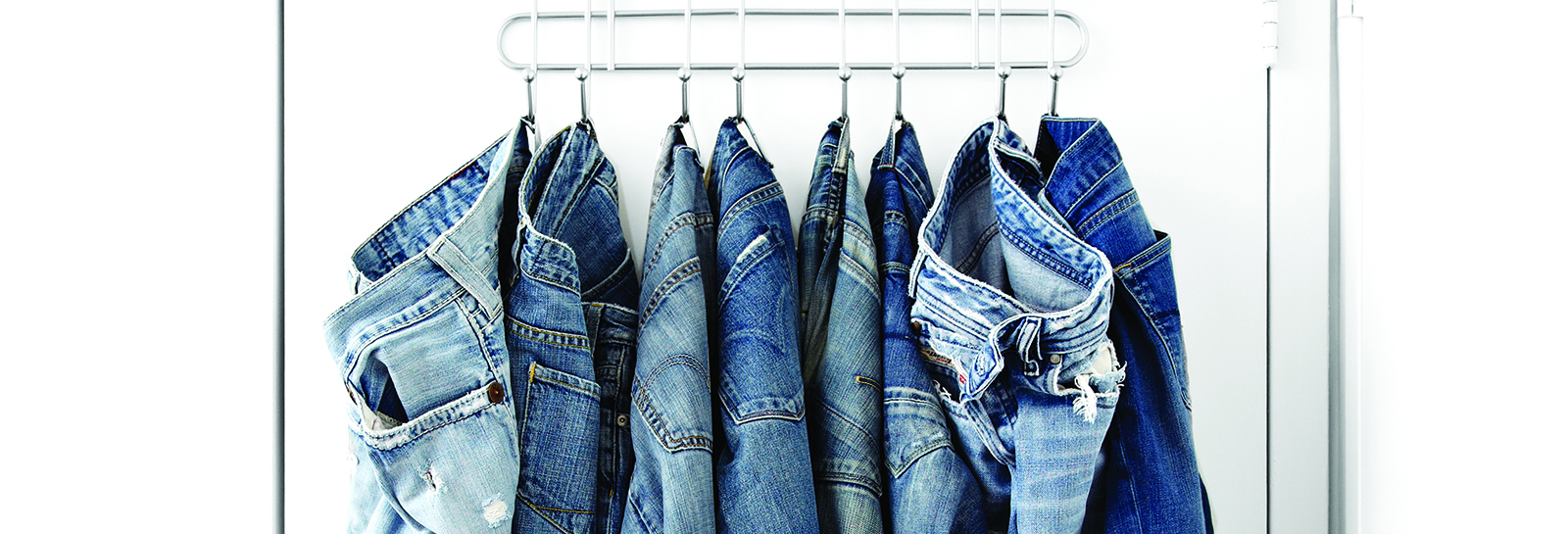Looking for a new pair of jeans?
You could hit the mall, buy the cheapest pair that fits just right and head home happy. Or you could research jean fabric origins online, find a company with sustainable production and fair hiring practices, and look for jeans that boast raw stretch denim, unique chain stitching and front pockets whose insides are hand-signed by the designer. Then, when you find the right pair, you could also buy a special washing liquid for raw denim and look forward to the months of wear — before the special wash comes into play—that it’ll take to break in your new jeans.
If the second shopping route is more your style, you’re a denim head — someone who’s seriously into all things denim, including the experience of shopping for the perfect pair and developing a just-right fade. “Increasingly, consumer spending is bifurcating into two very distinct segments,” says Doug Stephens, a retail industry futurist and founder of Retail Prophet. “High-convenience commodity brands and high-fidelity experience-based brands.” Specialty denim makers are the latter.
Passionate, discriminating denim heads are the target market for small, exclusive and bespoke brands. And these consumers’ desire for authenticity and quality also makes them the perfect audience for content marketing campaigns that tell the story behind every stitch and the experience of wearing it — with the goal of driving awareness, conversion and sales.
These consumers may be seeking a unique type of detailing or limited-edition products made on old, restored textile machines, and they’re willing to put in the time and the cash to get exactly what they want. “The people who come to our shop are interested in a few different things, or they may be interested in what we’re doing for different reasons,” says Victor Lytvinenko, co-founder and designer at Raleigh Denim Workshop. “Some care that the jeans are made in America. Some people are really interested in the fashion, style and fit. And some are interested in the authenticity of the story — how we do what we do, why we do what we do and the details of the fabric, the stitching and the machines.”
“Sure, you’re selling denim, but more importantly, you’re selling an idea or feeling about the brand.”
DOUG STEPHENS
FOUNDER, RETAIL PROPHET
The fabric of success
The denim market is big and it’s growing fast. Retail sales of denim jeans worldwide were $86.6 billion in 2012, $100.2 billion in 2016 and are projected to hit $129.8 billion in 2021, according to Statista.
Market research firm Global Industry Analysts names Diesel, 7 For All Mankind, Gap and Lee Jeans among the top players in the denim market — but a search for denim brands online yields a list of more than 400 companies, including niche makers like Paige, M.i.H Jeans and Frame.
Just as all of these brands are creative with their designs, they’re also creative with their marketing, using print, digital, video and even podcasts (yes, podcasts) to their advantage.
Even for denim heads, the clothing category, and raw denim in particular, can be confusing.
Focus on educational content
What quality indicators should I look for? What does “selvedge” mean? How does one care for raw denim? That’s why a lot of denim brands’ content focuses on education. Take Heddels, a website devoted to raw denim clothing and accessories, which offers 101 Primers, a glossary of denim terms, online guides like “The Best Entry-Level Raw Denim Jeans” and a free e-book called How to Buy Your First Pair of Raw Denim: 5 Simple Steps, which walks the buyer through everything from knowing your measurements to whether you want Sanforized (preshrunk) or un-Sanforized (not preshrunk) denim to choosing the right brand for your taste and style.
The response to Heddels’ educational content has been incredible: The site gets more than 200,000 unique visitors and 1,000,000 page views each month. “There’s one video we have about washing jeans that gets viewed maybe 5,000 times per week,” says Managing Editor David Shuck. “It’s sort of ridiculous how many people are looking at that one. We have much more intensive videos we’ve done, where we’ve traveled to interview designers or show production processes, and the one that I made in my bathtub is by far the most popular.”
Many brands also create content that schools denim shoppers on not just how to choose and care for denim, but also on how their product is made — which gives consumers a glimpse into the mission and values of the brand. Take Nudie Jeans: The popular denim brand’s website offers a graphical production guide, in which users can click on a product type to view a map of where it’s made. You’ll discover, for example, that 50 percent of Nudie Jeans’ jackets are produced in Romania, 21 percent in Tunisia and 19 percent in Portugal. Click on each country and you’ll see a description of the manufacturer, including contact information, a photo of its cutting floor or sewing room and sometimes even a PDF audit summary.
Raw material for content producers
- Educate your audience to make them feel like insiders.
- Don’t ignore low-hanging fruit, like evergreen 101 guides and glossaries.
- Incorporate your brand’s story into your educational content.
Pair up with print magazines
Because serious denim heads value an authentic look and feel over mass production, some brands are turning to print to tell their artisanal stories. “Print can be effective when the pieces are highly unique, special or well-crafted,” Stephens says. “The world certainly doesn’t need another quarter-page ad or flyer, but beautifully designed things are timeless.”
The print content from Raleigh Denim Workshop is a far cry from the bland quarter-pager Stephens eschews; the company recently started experimenting with an actual newspaper — crinkly newsprint, inky smell and all — that shares details about what the brand does and why it does it. Shoppers can pick up the newspaper in the store or receive a copy along with their online order. “It’s kind of fun to actually hold something,” Lytvinenko says.
Then there’s A.P.C., the French ready-to-wear brand known for its raw-denim jeans, which published a print book in 2017 called A.P.C. Transmission. According to the Amazon description, “Part retrospective of the brand and part personal scrapbook and visual diary, the book includes invitations, postcards, ad campaigns, images of their stores and collaborations with other designers.” Big-name media like Vogue and the New York Times have lauded the book for its design sensibility and brainy take on fashion.
A.P.C.’s book, which is filled with what GQ called “all manner of A.P.C. history, lore, design and ephemera,” offers readers the kind of rich detail they’d expect from the company’s clothing — and it costs almost $80, which only heightens the brand’s luxe feel. “It really comes down to deciding what the essence of the brand is beyond the product,” says Stephens. “What are you really selling? Is your brand about empowerment? Is it about self-confidence? Is it about sexuality? Sure, you’re selling denim, but more importantly, you’re selling an idea or feeling about the brand.”
Print can be used to sell — and to tell. In the fashion world, there are lookbooks — collections of photos meant to show off the look of their products — and there are photobooks, which some brands use to convey the story of their products.
The Japanese clothing brand Kapital, which got its name from being founded in Kojima, the “denim capital of Japan,” creates elaborate print catalog lookbooks twice a year for its collections. “They travel with the same photographer, and usually the same models and stylists, to different, random places in the world,” explains Heddels’ Shuck. “They’ve been to Iceland, Mongolia, Budapest. They tell the story of the clothes through images with these same models, and you get to see the evolution of these people and the brand. I think the book that they create for their collection every year is just as important as the collection itself.”
Raw material for content producers
- Opt for print content for an authentic look and feel.
- Use images to tell stories, not just showcase products.
- Don’t be afraid to go long-form, from feature-length articles to full-sized books.
Video marketing is king
Video is a natural format for denim companies to tell their story. And a smart choice: Video can impart important aspects of a denim brand’s story without requiring a lot from the viewer. “Sometimes our videos are about history, sometimes they’re about a detail, sometimes they’re about something that is just funny or cool or different, or sometimes they’re a really deep-rooted philosophical moment of inspiration,” says Lytvinenko about Raleigh Denim Workshop’s videos. “They’re only around one minute, so you don’t need a lot of buy-in, and people can watch them any time.” One example is “This Is Wear,” a short video that features co-founder Sarah Yarborough analyzing a pair of her old jeans and pointing out the fade on one pocket that indicates where an “old-school” iPhone was kept, and the blown-out knee on one leg that resulted from her always kneeling on that knee while hemming.
Denham the Jeanmaker, which was founded by Amsterdam-based designer Jason Denham, offers quick-hit videos that explain how the company works. Its documentary about the company, “The Truth Is in the Details,” under four minutes long, has gotten more than 25,000 views.
G-Star, which credits itself with “the positioning of raw, untreated denim as a wearable and desirable material,” also relies heavily on video to tell the brand’s story: The popular denim brand posts videos on YouTube, Facebook and Instagram that give viewers behind-the-scenes looks at, for example, the company’s denim archives and how their designers go from idea to completed product.
Podcasting as a marketing tool is gaining steam
Some denim players are creating podcasts — a surprising medium for such a visual industry. Naked & Famous Denim mixes it up: It produces a “podcast” that’s actually presented in video format. You can watch the hosts sit in front of a mic and talk about raw denim, the company’s year in review and other relevant topics.
On the pure sound side, Heddels produces a podcast (which is being revamped this year) that features historical pieces, fashion-show coverage and more. The podcast covers denim, but also other types of apparel that have the same “story” — meaning items that are made to last, that can take a good beating and that can be repaired.
Raw material for content producers
- Use unexpected content platforms to make your brand stand out.
- Keep videos short to lower the buy-in required from your audience.
- Create documentary-style videos (even quick ones) to highlight your mission and values.
Profile real people, not personas
Content-savvy denim brands are showcasing the real people who wear their products, usually in photos or videos. Denim company 3Sixteen takes the concept further by producing an online magazine called Singularities, which runs feature-length — think 4,000-plus words — profiles of the consumers who wear their jeans.
The lineup includes image-heavy, Q&A-style interviews with Rob Kolb and Anthony Accardi, founders of the craft beer company Transmitter Brewing in New York; motorcycle builder Len Higa; and people whose jeans have labored in tattoo parlors, furniture-building businesses, leather tanneries and more. By spotlighting industries with a strong focus on craft, 3Sixteen subtly brings the focus to the company’s own artistry. On the magazine’s About page, the editors note: “We hope that our vignettes accurately communicate [the profile subjects’] singularities to you: the facets of their personality which allow them to raise the bar in their respective industries.”
Denim brands are using inspired content marketing strategies to promote their products’ and their businesses’ authenticity, craftsmanship and mission, which resonates with consumers who share those values. The goal? Create a sense of community — and meaningful reason to buy.
“As brands become more globalized and the world becomes increasingly proliferated with goods, consumers are hungry for brands that offer a differentiated customer experience and brand story,” Stephens says. Denim companies do just that; they’re giving their customers the blues—in a good way.
Raw material for content producers
- Don’t always be brand-first. Use content to spotlight real people who use your brand.
- Profile subjects whose jobs, hobbies, attitudes or missions align with your brand story.
- Hire experienced journalists to craft believable customer profiles.




